A valuation of USD 4,802.4 million has been estimated for 2025 in the anti-wrinkle agents market, and this figure is projected to advance to USD 10,203.6 million by 2035. Over the decade, an increase of USD 5,401.2 million is expected, reflecting a 7.8% CAGR and more than a doubling of market size.
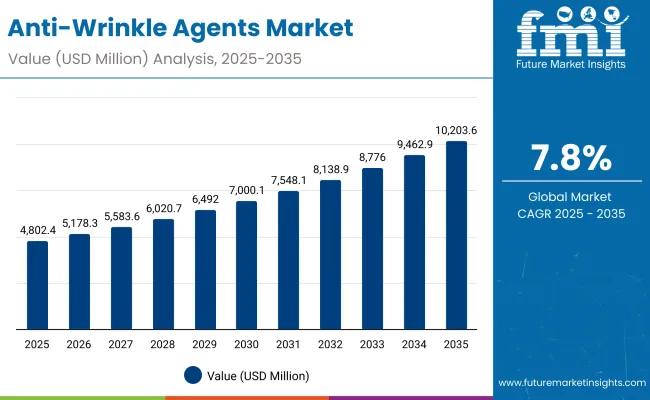
Anti-Wrinkle Agents Market Key Takeaways
| Metric | Value |
|---|---|
| Anti-Wrinkle Agents Market Estimated Value in (2025E) | USD 4,802.4 Million |
| Anti-Wrinkle Agents Market Forecast Value in (2035F) | USD 10,203.6 Million |
| Forecast CAGR (2025 to 2035) | 7.8% |
During the first half of the forecast period from 2025 to 2030, the market is expected to grow from USD 4,802.4 million to USD 7,000.1 million, delivering an addition of USD 2,197.7 million. This expansion is likely to account for approximately 41% of total decade growth, with demand anticipated to be supported by sustained consumer preference for premium skincare routines and wider incorporation of anti-aging regimens into everyday use. Encapsulated systems are expected to remain the most preferred delivery format, capturing 50% share in 2025, as ingredient stability and targeted release gain higher importance in formulation design.
In the second half of the outlook from 2030 to 2035, the market is projected to climb from USD 7,000.1 million to USD 10,203.6 million, contributing USD 3,203.5 million or nearly 59% of decade growth. This phase is expected to be marked by greater adoption of biotechnology-derived actives, forecast to hold 37% of total value in 2025 and gradually increase as cleaner, consistent raw materials are prioritized. Collagen & ECM stimulators are also expected to dominate mode of action, contributing 32% share in 2025, as clinical validation of fibroblast signaling and dermal regeneration continues to strengthen ingredient positioning.
Between 2020 and 2024, incremental growth was observed as the market transitioned toward advanced raw materials for anti-aging formulations. By 2025, the valuation is expected to reach USD 4,802.4 million, supported by demand for encapsulated and biotech-derived actives. Over the decade, expansion toward USD 10,203.6 million is projected, equating to a CAGR of 7.8%. Collagen & ECM stimulators are anticipated to remain the dominant mode of action, while encapsulated delivery systems are forecast to capture the largest formulation share.
Competition is expected to intensify as sustainability, clinical substantiation, and premium positioning define supplier advantage. Leading companies are projected to emphasize R&D in controlled-release technologies and biologically derived molecules to secure long-term contracts with formulators. The market is anticipated to reward suppliers able to combine efficacy with compliance support, technical services, and safety validation.
Growth in the anti-wrinkle agents market is being fueled by a combination of scientific innovation, consumer behavior shifts, and expanding application in premium skincare. Advances in biotechnology-derived actives are being adopted to deliver cleaner, more consistent raw materials that meet rising regulatory and sustainability standards. Encapsulation technologies are being utilized to ensure ingredient stability, targeted release, and enhanced efficacy, enabling formulators to create differentiated solutions that appeal to increasingly sophisticated consumers. Demand is being accelerated by heightened awareness of preventive skincare, particularly in high-growth regions such as China and India, where younger demographics are embracing serums and advanced treatment formats. The adoption of collagen and ECM stimulators is being prioritized as clinical data substantiates their role in dermal regeneration and fibroblast activation. Expansion in dermocosmetic and prestige skincare portfolios is expected to reinforce long-term ingredient demand, rewarding suppliers who align with safety, efficacy, and sustainability-driven innovation.
The anti-wrinkle agents market has been segmented into mode of action, source, and delivery system, highlighting the raw material categories shaping growth. Each segment represents a critical input influencing formulation strategies, efficacy claims, and market adoption. Mode of action segmentation underscores the biological pathways being prioritized in product design, while source analysis reflects the origin of actives driving demand in both synthetic and biotechnology-based categories. Delivery system segmentation provides insights into the mechanisms enabling controlled release and improved ingredient stability. Together, these segments illustrate how innovation in formulation science is transforming ingredient positioning, advancing clinical substantiation, and meeting consumer preferences for high-performance anti-aging solutions across global cosmetic and personal care industries.
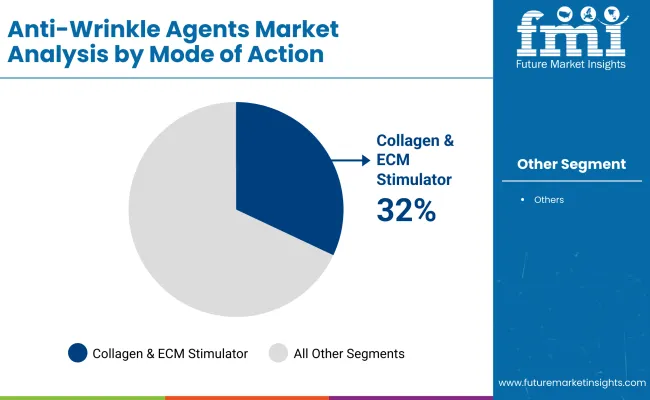
| Mode of Action | Market Value Share, 2025 |
|---|---|
| Collagen & ECM stimulators | 32% |
| Others | 68.0% |
Collagen & ECM stimulators are projected to hold 32% share in 2025, equating to USD 1,536.77 million, making them the leading mode of action in the anti-wrinkle agents market. Their dominance is expected to be reinforced by strong clinical backing for fibroblast activation and dermal matrix repair. The rising consumer demand for visible skin rejuvenation is anticipated to support greater inclusion of these actives in premium formulations. The remaining 68% (USD 3,265.63 million) is accounted for by other mechanisms, which will retain relevance for diversified formulations. However, the emphasis on collagen regeneration and extracellular matrix repair is expected to remain central to innovation pipelines, ensuring long-term positioning for this segment as a key growth driver in the market.
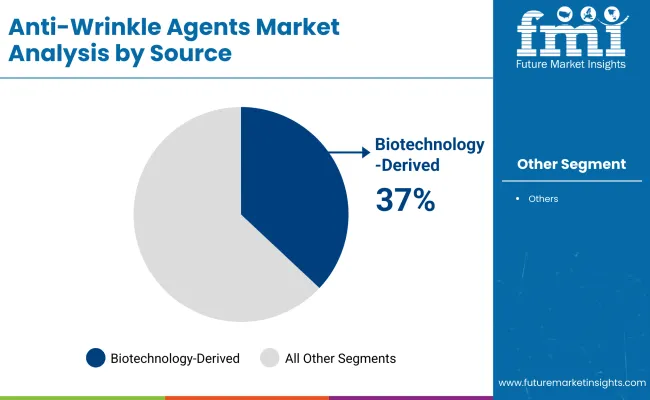
| Source | Market Value Share, 2025 |
|---|---|
| Biotechnology-derived | 37% |
| Others | 63.0% |
Biotechnology-derived ingredients are expected to represent 37% share in 2025, equal to USD 1,776.89 million, with adoption driven by growing demand for cleaner, consistent, and sustainable raw materials. Their role in advancing precision formulations and reducing variability is anticipated to strengthen procurement preference among leading cosmetic brands. The “others” category, valued at USD 3,025.51 million and accounting for 63% share, will remain important for affordability and legacy formulations. Nevertheless, biotechnology inputs are expected to capture incremental growth as regulatory pressures favor safer and traceable supply chains. With biotechnology offering scalability and innovation flexibility, this segment is forecast to capture expanding relevance in the decade ahead.
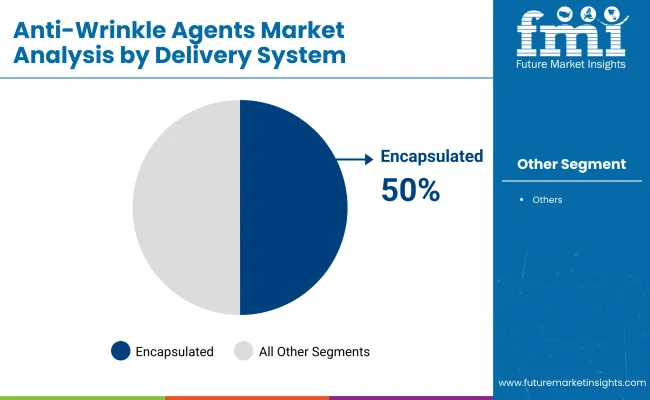
| Delivery System | Market Value Share, 2025 |
|---|---|
| Encapsulated | 50% |
| Others | 50.0% |
Encapsulated delivery systems are anticipated to account for 50% share in 2025, valued at USD 2,401.20 million, establishing themselves as a key driver of premium anti-wrinkle formulations. Their ability to enhance ingredient stability, improve penetration, and allow controlled release is expected to secure long-term adoption. The “others” category, also representing 50% (USD 2,401.20 million), will remain relevant for cost-sensitive applications, yet growth momentum is forecast to favor encapsulation. As demand for advanced actives increases, encapsulated systems are expected to be prioritized in both dermocosmetic and prestige skincare, reinforcing their positioning as the dominant delivery technology. Their alignment with evolving consumer preferences for efficacy and safety is projected to ensure sustained growth in this segment.
Complex formulation requirements and evolving regulatory scrutiny are shaping the anti-wrinkle agents market, even as growth is supported by advanced biotechnological inputs, encapsulation technologies, and the rising need for clinically validated efficacy in global skincare innovation pipelines.
Shift Toward Biotechnology-Derived Ingredients
The anti-wrinkle agents market is being reshaped as biotechnology-derived inputs are prioritized for their scalability, safety profiles, and reproducibility. Brand owners are increasingly aligning procurement strategies with actives that demonstrate consistent performance under clinical validation. This shift is expected to create sustained opportunities for suppliers able to deliver fermentation-based or bio-engineered actives supported by traceable supply chains. Biotech solutions are also anticipated to ease compliance in regions with tightening cosmetic regulations, ensuring long-term security of supply and reinforcing their competitive advantage in premium skincare formulations.
Encapsulation as a Competitive Differentiator
Encapsulation technologies are evolving from optional formulation enhancements to core differentiators in ingredient positioning. Controlled-release systems are being favored for their ability to maximize bioavailability, reduce irritation risk, and extend shelf-life. This trend is anticipated to transform how suppliers build value propositions, as encapsulation becomes a prerequisite for winning contracts with global beauty brands. Technical collaborations between ingredient developers and encapsulation technology firms are expected to intensify, with co-developed prototypes offered as turnkey solutions. As consumer preferences continue to demand efficacy alongside safety, encapsulation is projected to emerge as the benchmark standard across premium and dermocosmetic anti-wrinkle formulations.
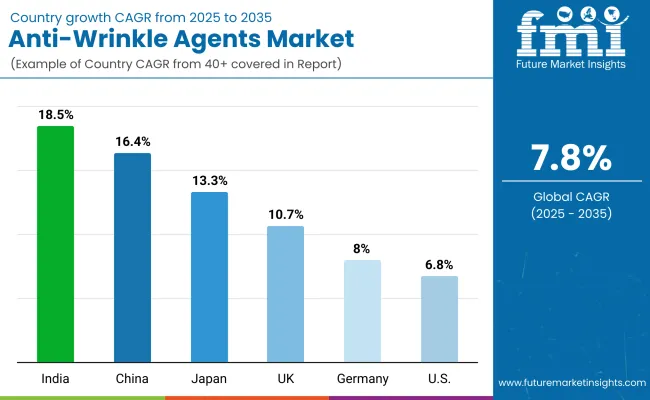
| Country | CAGR |
|---|---|
| China | 16.4% |
| USA | 6.8% |
| India | 18.5% |
| UK | 10.7% |
| Germany | 8.0% |
| Japan | 13.3% |
The Anti-Wrinkle Agents Market is projected to expand unevenly across regions, with growth trajectories influenced by consumer demographics, income dynamics, and innovation adoption in skincare formulations. Asia is anticipated to emerge as the leading growth hub, anchored by India at 18.5% CAGR and China at 16.4% CAGR, where younger demographics and rising urban middle classes are increasingly embracing preventive anti-aging solutions. This acceleration is expected to be further supported by local brand expansion and heightened preference for serums and high-performance formats.
Japan, with an estimated 13.3% CAGR, is projected to reinforce Asia’s position, driven by its longstanding reputation for premium dermocosmetics and continued emphasis on advanced actives. Europe is expected to post steady gains at 9.9% CAGR, with Germany at 8.0% and the UK at 10.7%, reflecting sustained alignment with stringent quality and safety standards in cosmetic formulations.
The U.S. market, growing at a more moderate 6.8% CAGR, is expected to remain significant in value terms but slower in pace, reflecting market maturity and established penetration of anti-aging solutions. Growth in Europe and North America is anticipated to be supported by innovation in biotechnology-derived actives and encapsulation, while Asia continues to dominate expansion momentum through scale and evolving consumer lifestyles.
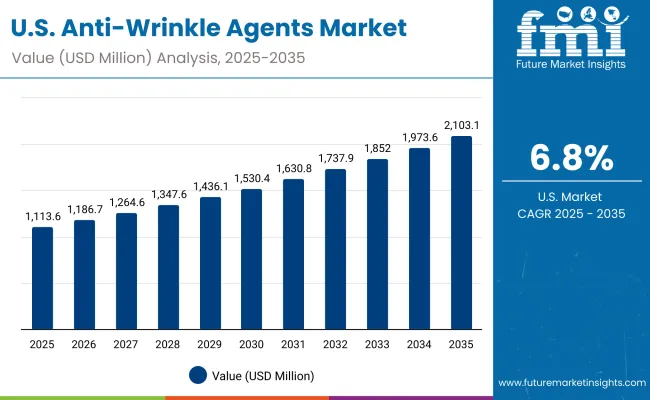
| Year | USA Anti-Wrinkle Agents Market (USD Million) |
|---|---|
| 2025 | 1113.62 |
| 2026 | 1186.72 |
| 2027 | 1264.63 |
| 2028 | 1347.65 |
| 2029 | 1436.13 |
| 2030 | 1530.41 |
| 2031 | 1630.88 |
| 2032 | 1737.94 |
| 2033 | 1852.04 |
| 2034 | 1973.62 |
| 2035 | 2103.19 |
The Anti-Wrinkle Agents Market in the United States is projected to expand at a CAGR of 6.8% from 2025 to 2035, supported by steady demand for advanced dermocosmetic and preventive skincare formulations. Over this period, the market is anticipated to more than double in value, creating strong opportunities for suppliers of biotech-derived and encapsulated actives.
Growth momentum is expected to be reinforced by increased consumer preference for clinically substantiated anti-aging solutions and heightened adoption of premium serums and creams. The U.S. market is anticipated to remain significant in global share, with expansion aligned to innovations in collagen and ECM stimulators. Regulatory scrutiny and transparent ingredient sourcing are projected to intensify, giving competitive advantage to suppliers with proven safety and efficacy credentials.
The Anti-Wrinkle Agents Market in the United Kingdom is projected to grow at a CAGR of 10.7% from 2025 to 2035, supported by steady adoption of advanced dermocosmetic solutions. Market expansion is expected to be reinforced by demand for clinically proven raw materials that align with consumer trust in efficacy and safety. Encapsulation is anticipated to emerge as a core delivery format, while collagen and ECM stimulators are forecast to gain stronger adoption in premium skincare. Regulatory oversight and sustainability benchmarks are projected to shape procurement, favoring biotechnology-derived inputs.
The Anti-Wrinkle Agents Market in India is forecast to expand at a CAGR of 18.5% from 2025 to 2035, making it the fastest-growing market globally. Expansion is anticipated to be supported by rapid consumer adoption of eye and neck treatments, alongside increased penetration of premium skincare across urban centers. Biotechnology-derived ingredients are expected to play a stronger role in procurement strategies as transparency and efficacy become critical to brand positioning. Rising disposable incomes and early interest in preventive skincare among younger consumers are projected to accelerate adoption.
The Anti-Wrinkle Agents Market in China is projected to grow at a CAGR of 16.4% from 2025 to 2035, reflecting strong momentum in serum adoption and premium anti-aging formulations. Growth is anticipated to be driven by increasing consumer preference for biotech-derived actives, supported by large-scale brand expansions and heightened emphasis on clinical validation. Encapsulated delivery formats are expected to gain prominence, while local suppliers are projected to intensify competition with global ingredient leaders. Regulatory tightening on ingredient safety is anticipated to reinforce demand for transparent sourcing and scientifically backed efficacy.
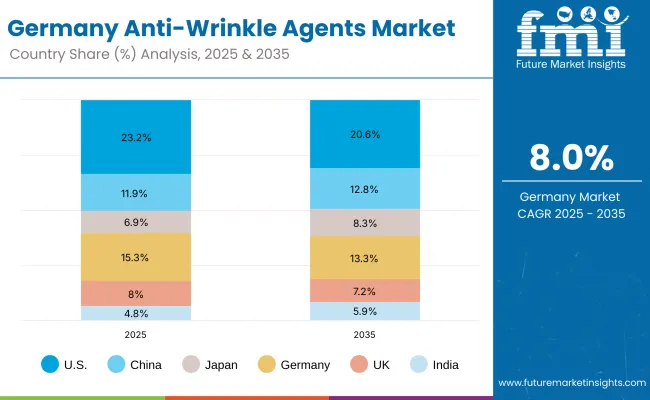
| Country | 2025 |
|---|---|
| USA | 23.2% |
| China | 11.9% |
| Japan | 6.9% |
| Germany | 15.3% |
| UK | 8.0% |
| India | 4.8% |
| Country | 2035 |
|---|---|
| USA | 20.6% |
| China | 12.8% |
| Japan | 8.3% |
| Germany | 13.3% |
| UK | 7.2% |
| India | 5.9% |
The Anti-Wrinkle Agents Market in Germany is forecast to advance at a CAGR of 8.0% from 2025 to 2035, driven by alignment with Europe’s strong regulatory and quality compliance environment. Demand is expected to be reinforced by dermocosmetic adoption, particularly for encapsulated actives that ensure stability and safety. Biotechnology-derived solutions are projected to grow in preference as sustainability-linked procurement becomes central to European brand strategies. Germany’s role as a hub for premium formulation development is expected to consolidate, giving suppliers opportunities to secure long-term partnerships with established cosmetic leaders.
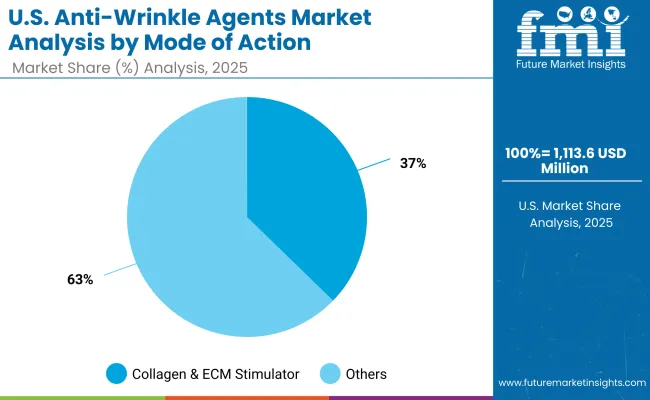
| USA By Mode of Action | Market Value Share, 2025 |
|---|---|
| Collagen & ECM stimulators | 37.3% |
| Others | 62.7% |
The Anti-Wrinkle Agents Market in the United States is projected at USD 1,113.62 million in 2025. Collagen & ECM stimulators contribute 37.3%, while other modes of action hold 62.7%, reflecting a diversified approach to dermal regeneration and anti-aging solutions. This balance indicates that, although collagen stimulation is positioned as a clinically validated mechanism, multiple pathways continue to be integrated into formulations to broaden efficacy claims and market reach.
Collagen & ECM stimulators are expected to gain stronger prominence over the forecast period as demand for actives with measurable biomarker performance rises. Their positioning is supported by enhanced fibroblast activation data and alignment with preventive skincare strategies. Other modes of action are projected to remain dominant in value terms, enabling flexibility for formulators targeting varied consumer segments.
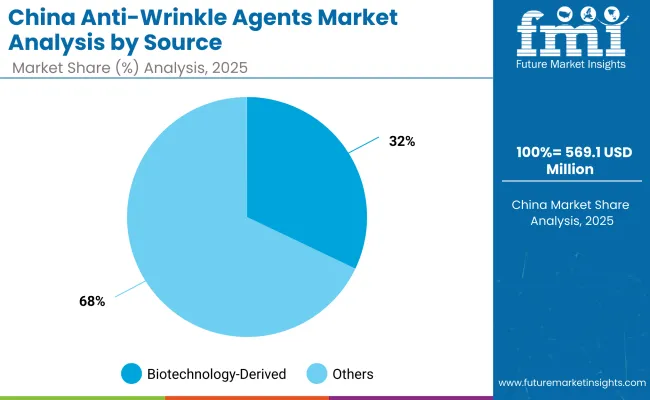
| China By Source | Market Value Share, 2025 |
|---|---|
| Biotechnology-derived | 32.1% |
| Others | 67.9% |
The Anti-Wrinkle Agents Market in China is projected at USD 569.18 million in 2025. Biotechnology-derived inputs contribute 32.1%, while other sources hold 67.9%, reflecting the country’s transition from legacy formulations toward advanced and traceable actives. This share distribution indicates that biotechnology is becoming an essential driver of differentiation, even as traditional inputs maintain a significant role in volume.
Biotechnology-derived actives are expected to gain wider prominence as local formulators prioritize sustainability, consistency, and clinically validated performance. Strong consumer demand for serums and high-efficacy solutions is anticipated to accelerate the shift, particularly in premium and dermocosmetic ranges. Other raw materials will continue to dominate in cost-sensitive segments but are projected to face pressure as biotech scalability improves.
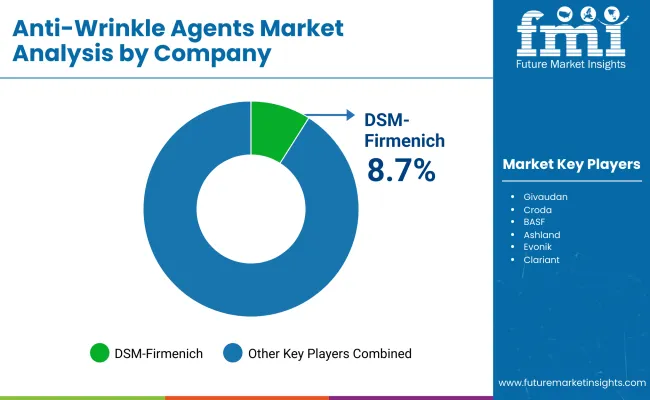
| Company | Global Value Share 2025 |
|---|---|
| DSM-Firmenich | 8.7% |
| Others | 91.3% |
The Anti-Wrinkle Agents Market is moderately fragmented, with leading global ingredient suppliers, established chemical innovators, and niche biotech specialists competing across formulation categories. DSM-Firmenich is identified as the most dominant company, holding a global market share of 8.7% in 2025, supported by its diversified portfolio of bioactive molecules and strong clinical substantiation capabilities. Its strategy is expected to emphasize biotechnology-derived actives and encapsulation partnerships, allowing deeper integration into premium dermocosmetic launches.
Other global players, including Givaudan, Croda, BASF, Symrise, Ashland, Evonik, Clariant, Seppic, and Mibelle Biochemistry, are competing on sustainability credentials, regulatory alignment, and technical service offerings. Their competitive advantage is expected to be reinforced by proprietary delivery technologies and expanding collaborations with cosmetic brands seeking traceability and compliance-ready ingredient solutions.
The broader competitive field, representing 91.3% of market share in 2025, is occupied by mid-sized and niche suppliers specializing in botanical extracts, functional polymers, and tailored encapsulation systems. These players are anticipated to gain traction by addressing localized consumer preferences and providing cost-competitive alternatives for high-volume formulations.
Competitive differentiation is shifting from traditional ingredient supply toward integrated value propositions, where efficacy validation, safety documentation, and sustainability reporting are bundled as part of procurement packages. Over the forecast period, leadership is expected to be secured by companies that can align clinical efficacy, biotechnological innovation, and regulatory readiness into cohesive growth strategies.
Key Developments in Anti-Wrinkle Agents Market
| Item | Value |
|---|---|
| Quantitative Units | USD 4,802.4 Million (2025E); USD 10,203.6 Million (2035F); CAGR 7.8% (2025 to 2035) |
| Mode of Action | Collagen & ECM stimulators (32% share, USD 1,536.77 Million in 2025); Others (68% share, USD 3,265.63 Million in 2025) |
| Source | Biotechnology-derived (37% share, USD 1,776.89 Million in 2025); Others (63% share, USD 3,025.51 Million in 2025) |
| Delivery System | Encapsulated (50% share, USD 2,401.20 Million in 2025); Others (50% share, USD 2,401.20 Million in 2025) |
| Physical Form | Encapsulated, Solution/Concentrate, Powder, Emulsion Concentrate (each contributing to balanced value creation) |
| Application | Serums, Creams & Lotions, Eye/Neck Treatments, Masks & Patches |
| End-Use Industry | Skincare, Sun Care, Color Cosmetics |
| Regions Covered | North America, Europe, East Asia, South Asia & Pacific, Latin America, Middle East & Africa |
| Countries Covered | United States, Germany, United Kingdom, China, Japan, India |
| Key Companies Profiled | DSM-Firmenich (8.7% global share in 2025), Givaudan, Croda, BASF, Symrise, Ashland, Evonik, Clariant, Seppic, Mibelle Biochemistry |
| Additional Attributes | Dollar sales by mode of action, source, delivery system, and application; adoption of encapsulation as a differentiator; rapid growth in biotechnology-derived actives; preventive skincare trends in Asia; clinical validation and safety data as procurement benchmarks; sustainability and traceability as competitive drivers. |
The Anti-Wrinkle Agents Market is estimated to be valued at USD 4,802.4 million in 2025.
The market size for the Anti-Wrinkle Agents Market is projected to reach USD 10,203.6 million by 2035.
The Anti-Wrinkle Agents Market is expected to grow at a CAGR of 7.8% between 2025 and 2035.
The key product types in the Anti-Wrinkle Agents Market are Collagen & ECM stimulators, Biotechnology-derived actives, and Encapsulated delivery systems.
In terms of mode of action, Collagen & ECM stimulators are projected to command a 32% share of the Anti-Wrinkle Agents Market in 2025.






Our Research Products

The "Full Research Suite" delivers actionable market intel, deep dives on markets or technologies, so clients act faster, cut risk, and unlock growth.

The Leaderboard benchmarks and ranks top vendors, classifying them as Established Leaders, Leading Challengers, or Disruptors & Challengers.

Locates where complements amplify value and substitutes erode it, forecasting net impact by horizon

We deliver granular, decision-grade intel: market sizing, 5-year forecasts, pricing, adoption, usage, revenue, and operational KPIs—plus competitor tracking, regulation, and value chains—across 60 countries broadly.

Spot the shifts before they hit your P&L. We track inflection points, adoption curves, pricing moves, and ecosystem plays to show where demand is heading, why it is changing, and what to do next across high-growth markets and disruptive tech

Real-time reads of user behavior. We track shifting priorities, perceptions of today’s and next-gen services, and provider experience, then pace how fast tech moves from trial to adoption, blending buyer, consumer, and channel inputs with social signals (#WhySwitch, #UX).

Partner with our analyst team to build a custom report designed around your business priorities. From analysing market trends to assessing competitors or crafting bespoke datasets, we tailor insights to your needs.
Supplier Intelligence
Discovery & Profiling
Capacity & Footprint
Performance & Risk
Compliance & Governance
Commercial Readiness
Who Supplies Whom
Scorecards & Shortlists
Playbooks & Docs
Category Intelligence
Definition & Scope
Demand & Use Cases
Cost Drivers
Market Structure
Supply Chain Map
Trade & Policy
Operating Norms
Deliverables
Buyer Intelligence
Account Basics
Spend & Scope
Procurement Model
Vendor Requirements
Terms & Policies
Entry Strategy
Pain Points & Triggers
Outputs
Pricing Analysis
Benchmarks
Trends
Should-Cost
Indexation
Landed Cost
Commercial Terms
Deliverables
Brand Analysis
Positioning & Value Prop
Share & Presence
Customer Evidence
Go-to-Market
Digital & Reputation
Compliance & Trust
KPIs & Gaps
Outputs
Full Research Suite comprises of:
Market outlook & trends analysis
Interviews & case studies
Strategic recommendations
Vendor profiles & capabilities analysis
5-year forecasts
8 regions and 60+ country-level data splits
Market segment data splits
12 months of continuous data updates
DELIVERED AS:
PDF EXCEL ONLINE
Matting Agents Market Size and Share Forecast Outlook 2025 to 2035
Healing Agents Market (Skin Repair & Soothing Actives) Market Size and Share Forecast Outlook 2025 to 2035
Foaming Agents Market Size and Share Forecast Outlook 2025 to 2035
Firming Agents Botox-Like Market Size and Share Forecast Outlook 2025 to 2035
Heating Agents Market Size and Share Forecast Outlook 2025 to 2035
Cooling Agents Market Size and Share Forecast Outlook 2025 to 2035
Firming Agents Market Growth – Product Innovations & Applications from 2025 to 2035
Raising Agents Market Trends – Growth & Industry Forecast 2024 to 2034
Weighing Agents Market Size and Share Forecast Outlook 2025 to 2035
Draining Agents Market Size and Share Forecast Outlook 2025 to 2035
Flatting Agents Market Size and Share Forecast Outlook 2025 to 2035
Clouding Agents Market Trends - Growth Factors & Industry Analysis
Cognitive Agents Market Size and Share Forecast Outlook 2025 to 2035
Anti-Acne Agents Market Size and Share Forecast Outlook 2025 to 2035
Flavoring Agents Market Size and Share Forecast Outlook 2025 to 2035
Leavening Agents Market Analysis - Size, Growth, and Forecast 2025 to 2035
Market Share Breakdown of Anti-Slip Agents Manufacturers
Coalescing Agents Market Size and Share Forecast Outlook 2025 to 2035
Mattifying Agents Market Size and Share Forecast Outlook 2025 to 2035
Biocontrol Agents Market Size and Share Forecast Outlook 2025 to 2035

Thank you!
You will receive an email from our Business Development Manager. Please be sure to check your SPAM/JUNK folder too.
Chat With
MaRIA